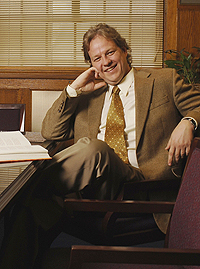Getting Native American culture right
An online course hopes to set the record straight

Many people still imagine Native Americans as people who wore headdresses and lived in tepees. Not even close, says Greg Salyer, associate professor and chair of the Department of Liberal Studies in Metropolitan College. This summer Salyer wants to set the record straight in his course Interior and Exterior Landscapes: Understanding Native American Cultures.
“Every time I teach this course, students note, with various levels of disappointment and even anger, that no one ever taught them about Native Americans and the important issues their cultures raise for Americans of all ethnicities,” says Salyer, who teaches the course online. “This ignorance is typical of American understandings of the original inhabitants of the continent. We expect Native Americans to exist in museums or, if they exist now, to look like something out of a western.”
Another myth, says Salyer, is that Native Americans are a vanishing people. In fact, their numbers are growing. According to the U.S. Census Bureau, the American Indian and Alaska native population rose by 1 percent, or 43,000, from 2004 to 2005. The census also reports that in 2005 the American Indian and Alaska native population was younger than the general population, with approximately 29 percent under the age 18, compared with 25 percent in the total population.
To help students understand that many of their ideas about Native Americans are false and culturally biased, Salyer asks them to complete the Implicit Association Test and other online activities created by the Office of Distance Education. Students then learn the truth about Native Americans through the latter’s writings, poems, and dramas, and they witness their cultural and religious traditions, read about how they have been portrayed and represented throughout history, and obtain a glimpse into their modern-day experiences.
“One of the main criticisms Native people have about their existence in the larger American culture is that their voices are not heard,” says Salyer. “Worse still, their voices are replaced by people who are not Native but claim to speak for them. As a non-Native person, I have to be sure not to elide those voices with my own or someone else’s. The best way to do that is to read the works of Native Americans themselves. Literature provides the kind of free and open space we need to understand those voices.”
Of the six students in the class, which runs through June 30, one is living near an Indian reservation in Ontario this summer, and another is playing hockey in Alaska, the home state of many Native people.
Salyer says that in the best cases, what students learn in his class will change their lives. “And at the very least,” he says, “I’d like them to know that there are Native people living here in America, who have stories and lives that are different from the ones we know and live by. The United States has been remarkably resistant to making adjustments to its mythology or its history. Native Americans’ presence reminds us that they were the original inhabitants of the ‘New World’ and that they were the victims of a 500-year genocide that was justified with religious and political excuses. It’s a hard history for Euro-Americans to face, but until we do, we won’t know ourselves completely, much less the people whose land we walk upon today.”